Reduce plastic waste and learn how to make a reusable DIY bread bag that keeps homemade bread, fresher longer and makes for a great gift for the bakers in your life!
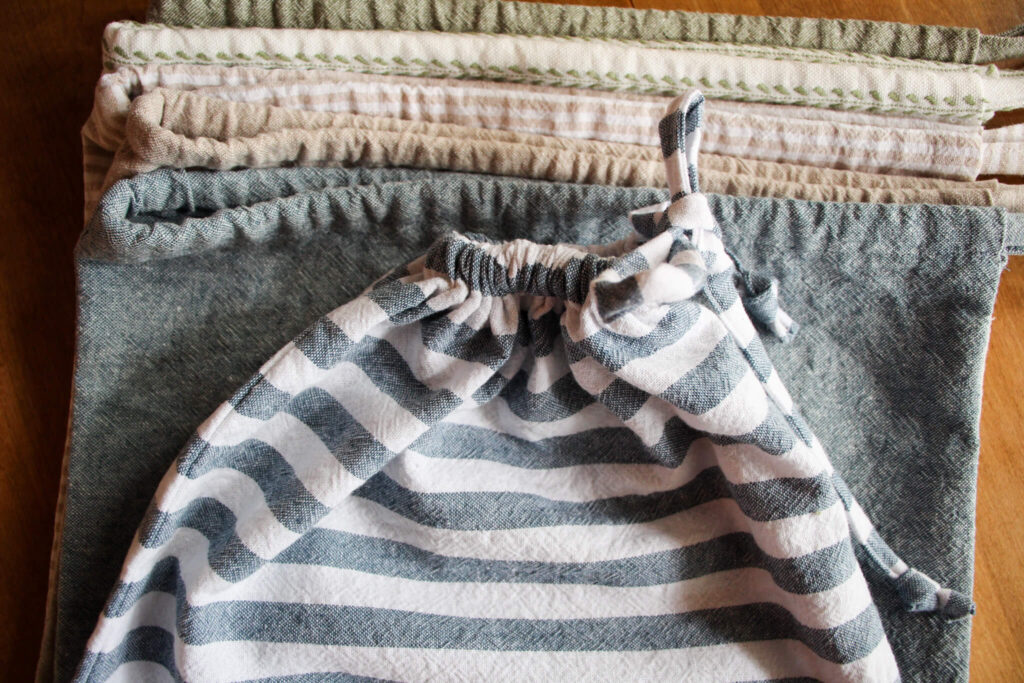
**UPDATED MAY 15, 2024**
I’ve been making homemade bread for quite a while now and in the beginning, I always had a hard time finding a good solution for storing it. My previous solution was to put my bread in a plastic zip top bag and store it in the refrigerator. Homemade bread doesn’t keep as long as grocery store bread because it lacks preservatives, so it tends to get moldy quickly. Storing it in the refrigerator helps keep bread “fresh” longer. The problem with storing bread in the refrigerator is it becomes hard and dry quickly. The only good way to eat the bread is toasted because the refrigerator sucks all the moisture out.
So, in an effort to reduce my plastic use and keep my homemade bread fresher, longer, I thought I’d try my hand at making a reusable DIY bread bag! These bags are great for storing fresh bread, sourdough bread and other baked goodies. In this tutorial, I’ll go over how to easily create your own reusable bread bag and will give you instructions for a bag that fits two loaves and a bag that fits one loaf! I’ve also included a video tutorial if you’re more of a visual person!
PIN IT FOR LATER!
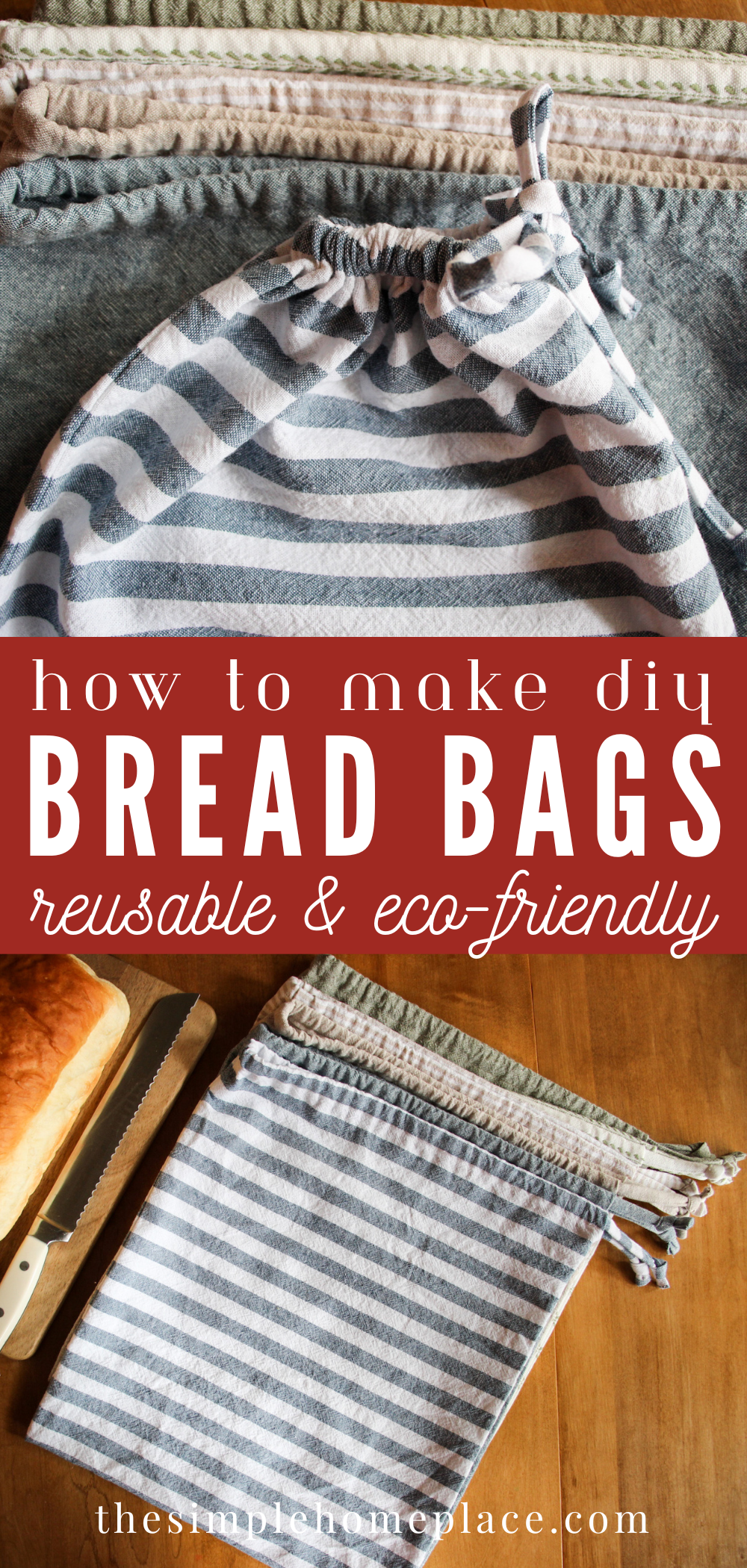
FAQs
Do fabric bread bags work?
They really do! The beauty of DIY bread bags is that the material used (typically cotton or linen) allows for airflow in the bag. This airflow prevents moisture from building up and creating mold. It also keeps the crust crusty, and the inside nice and soft.
How do you use DIY linen bread bags?
Place your cooled bread or baked goods into the clean bag and cinch the ties, then tie them. Store the bread in a cool, dark place for about 3-5 days, depending on the temperature of your home. To keep bread fresher even longer on the counter, I recommend wrapping your bread in a reusable beeswax food wrap. This makes a huge difference when it comes to freshness and allows for longer countertop storage.
How do you care for linen bread bags?
Once your bag is dirty, shake out any crumbs into the garbage, then either hand wash or wash on a delicate cycle in cold. I recommend air drying, but you can dry on low. I personally don’t follow my own rules and have washed and dried these bags as I normally would and they’ve lasted years. BUT to keep them longer, I recommend following the first care instructions 🙂
Can you freeze bread in bread storage bags?
You can absolutely freeze your bread in these bags. If you do plan to do that, I recommend wrapping the bread in plastic wrap, if that’s something you use. It just is an added layer of protection against freezer burn. If you don’t like plastic wrap, you could try placing the bread in a paper bag, then in the bread bag. Bread can be stored this way for up to 3 months in the freezer.
VIDEO TUTORIAL
This post may contain affiliate links, which means I may receive a commission, at no extra cost to you, if you make a purchase through a link. Please see our full disclosure here for further information.
TOOLS YOU MAY NEED
- Sewing machine
- Iron and ironing board
- Rotary cutter and cutting pad
- Scissors
- Pinking sheers (optional)
- Fabric tape measure
- Pins
- Safety pin
MATERIALS
- 1/2 yard linen fabric or 100% cotton fabric
- 100% cotton or all purpose coordinating thread
HOW TO MAKE A REUSABLE DIY BREAD BAG
LARGE SIZE
Cut a piece of linen or 100% cotton fabric that is 30 inches long.
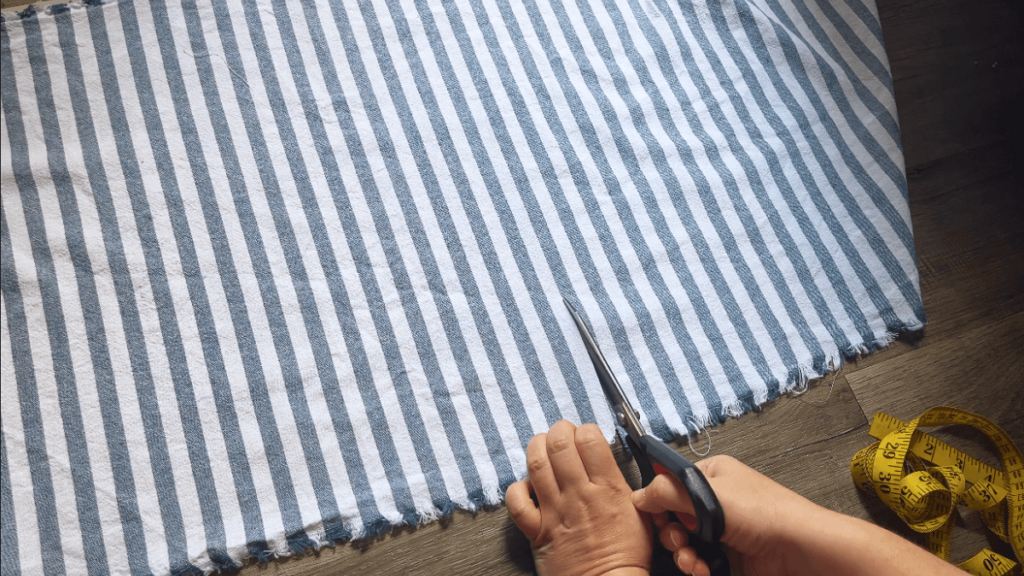
Fold the cut piece of fabric in half, lining up the two short sides, with the wrong side of the fabric facing out. Press the folded edge with an iron, then place a handful of pins throughout the fabric to keep the two pieces together.
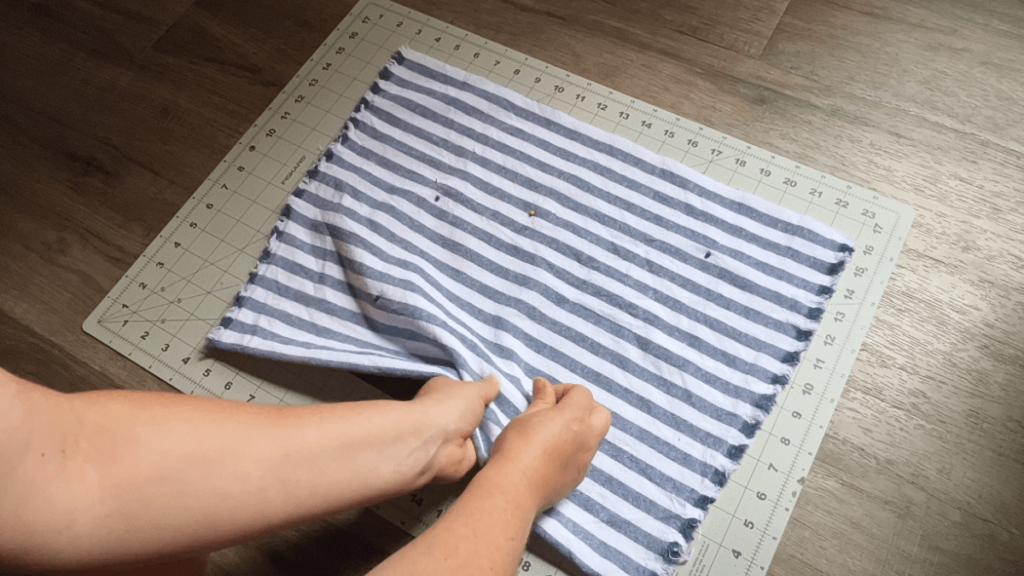
Trim the selvage edge from the left side of the fabric then cut the fabric to a width of 13″.
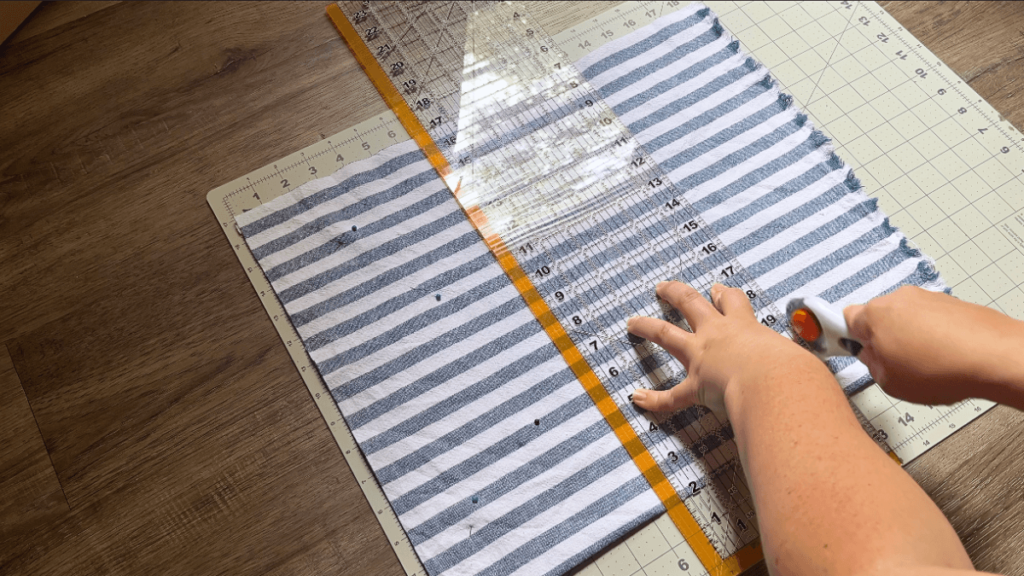
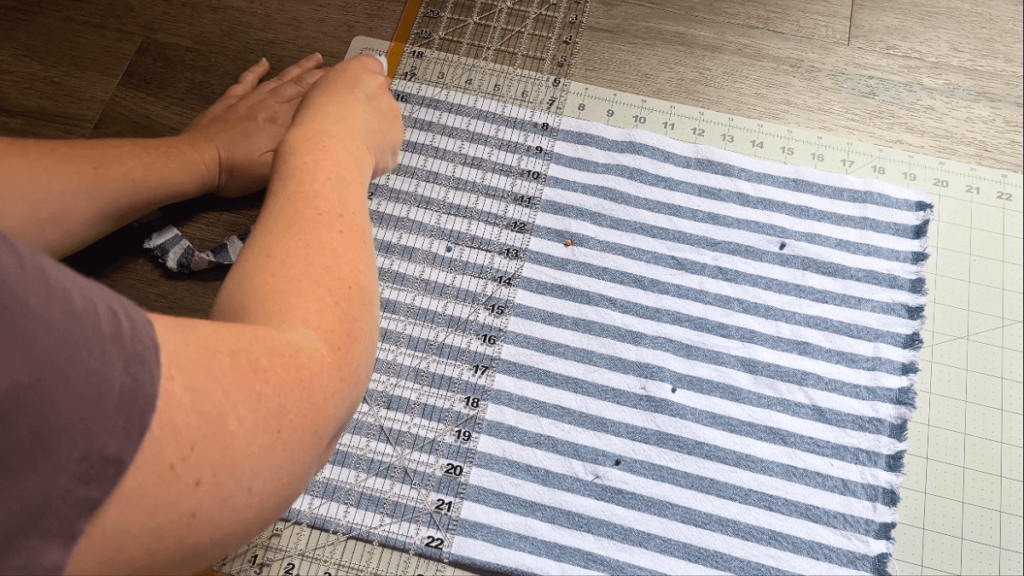
Using your fabric measuring tape, mark two inches from the top (the side that is open) and place a pin through both pieces of fabric.
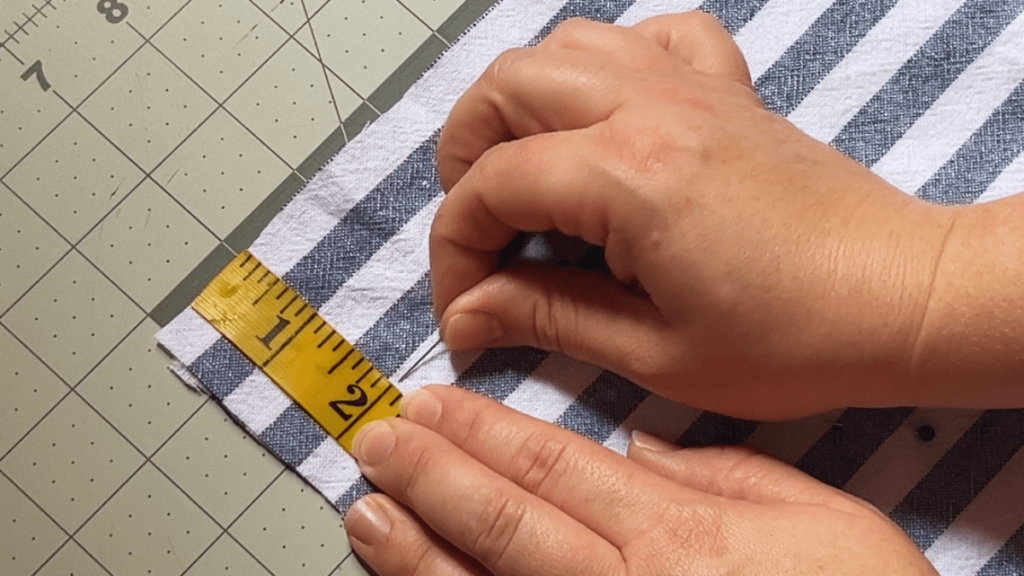
Using a 1/2 inch seam allowance, sew along each long side, making sure to forward and backward stitch at the top and bottom. On the side with the pin, be sure to stop when you get to the pin. For extra strength on the side seams, repeat the previous step, sewing with a 3/8″ seam allowance.
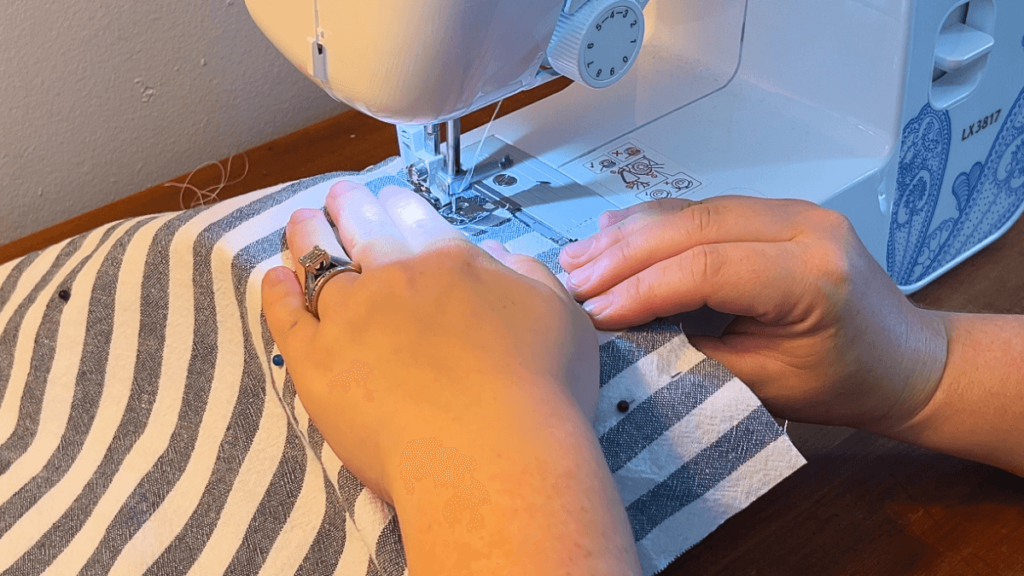
Trim off the excess fabric on the sides you just sewed, leaving about 1/4 inch of fabric on either side. Use pinking shears if you have them to help prevent fraying.
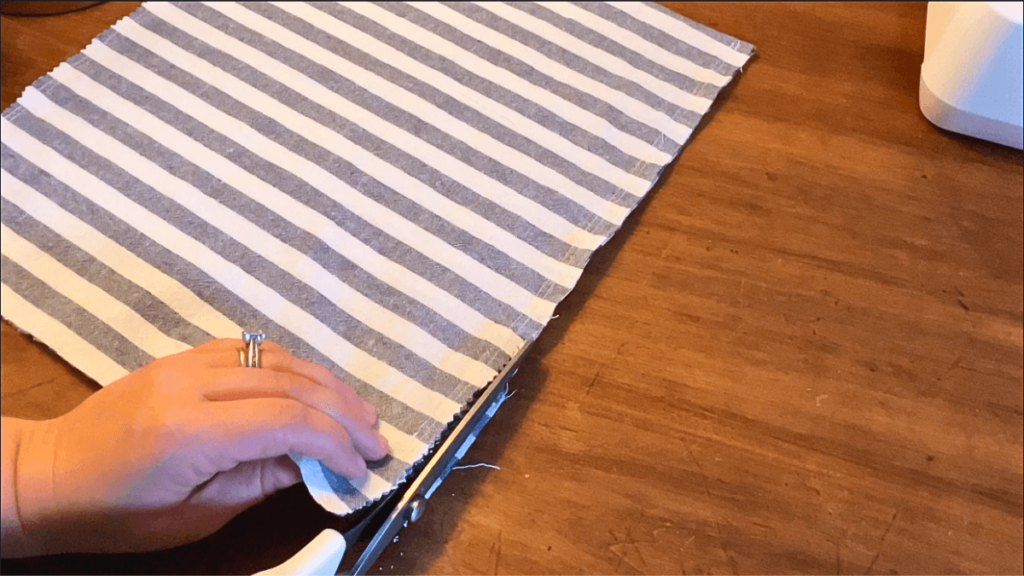
Flip the bag right side out and push the corners out using a blunt object like the end of scissors or a crochet hook, then press the entire bag again.
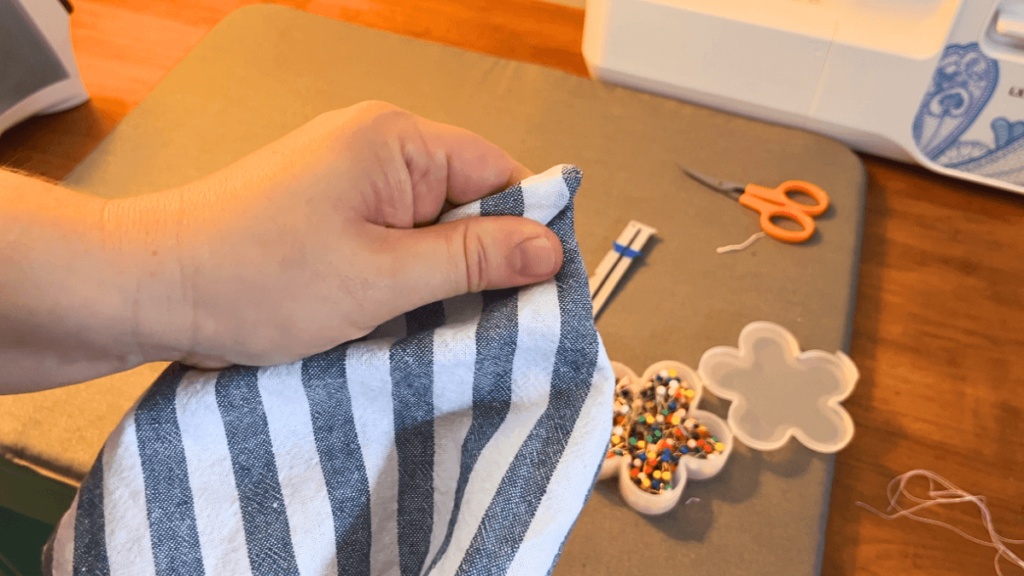
At the top of the bag where the opening is, fold down the raw edges about 1/2 inch and press. Then fold it over again, lining it up with the two inch mark, and press again.
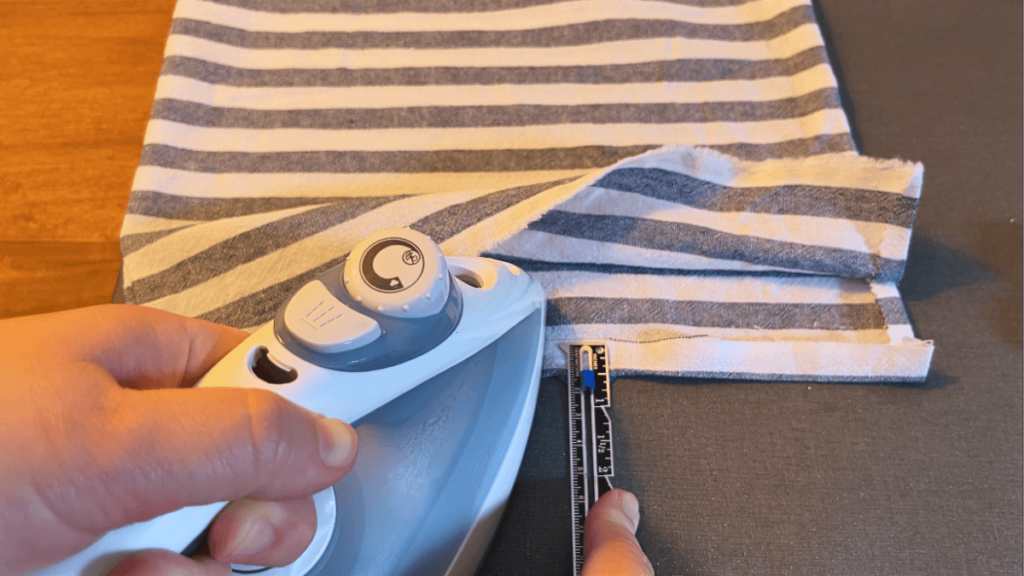
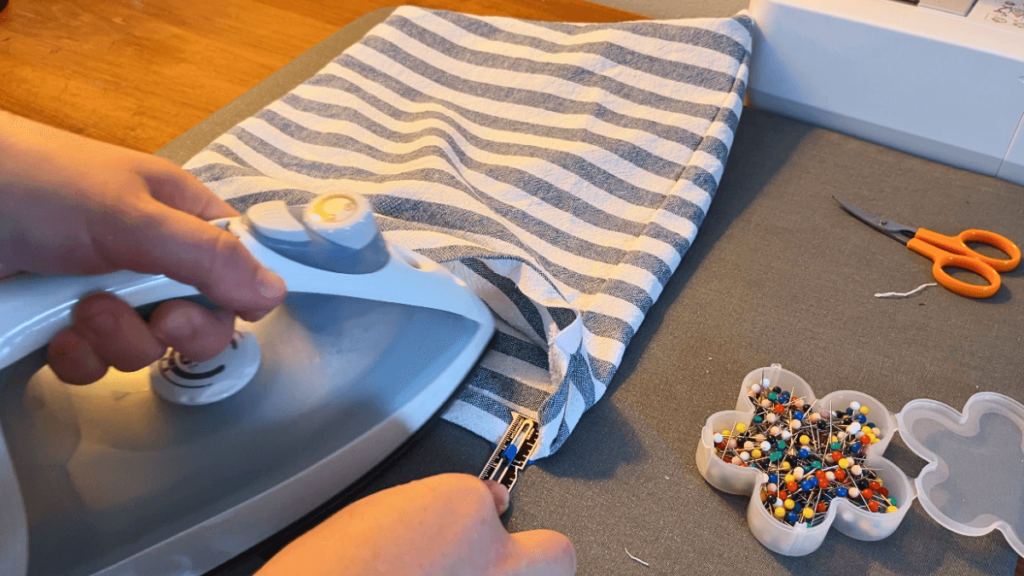
Turn the bag wrong sides out again, then sew the bottom of the fold (the open end) as close to the edge as you can (top stitch), making sure to forward and backward stitch at the beginning and end. This will create a channel for the tie.
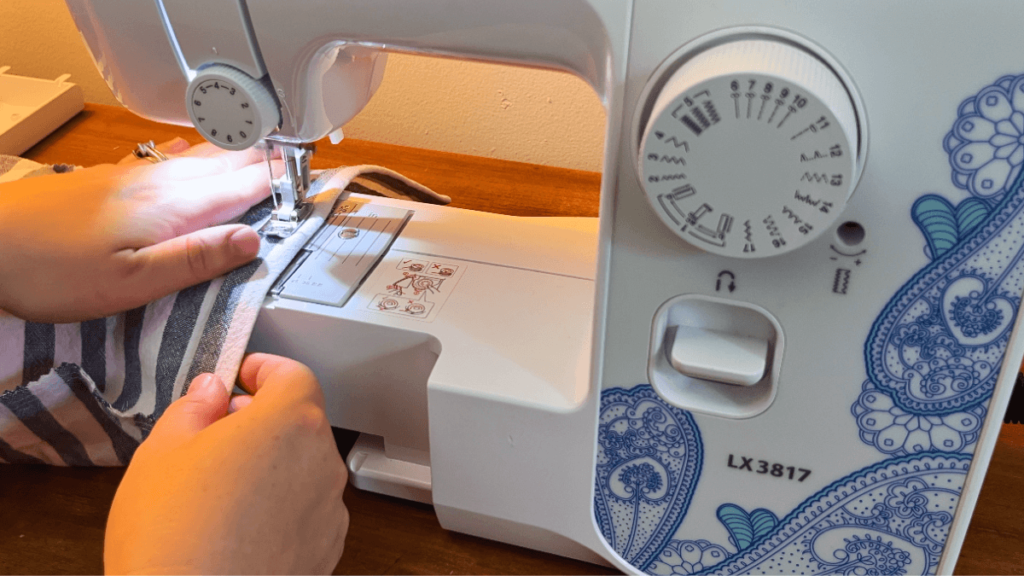
How to Make the Ties
Cut a strip of the same fabric that is 31 inches long by 2 inches wide. You may have to cut two pieces, sew them together, then re-measure and cut.
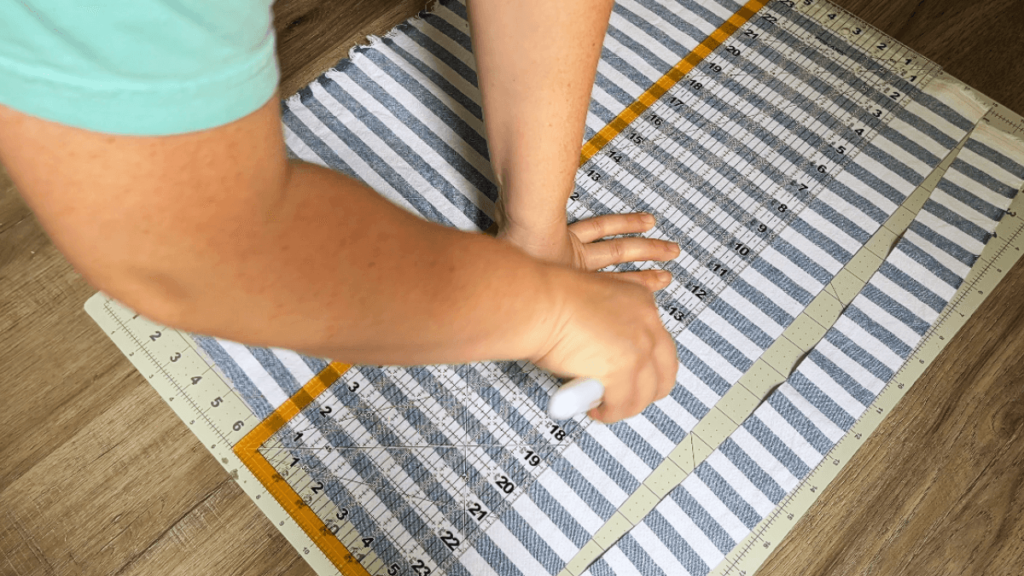
Fold the short ends 1/4 inch and press.
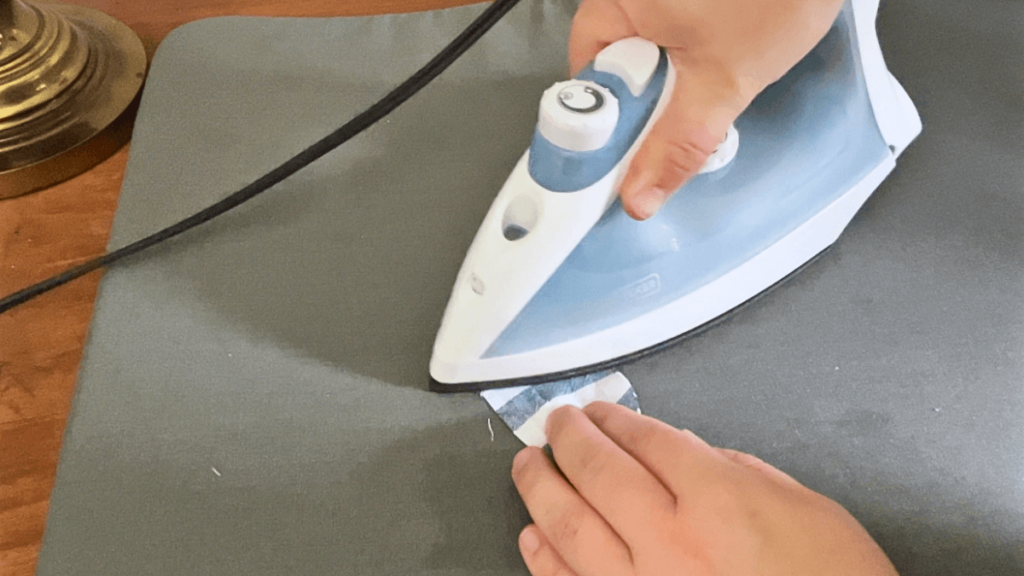
Then fold down one long side about 3/4 inch and press.
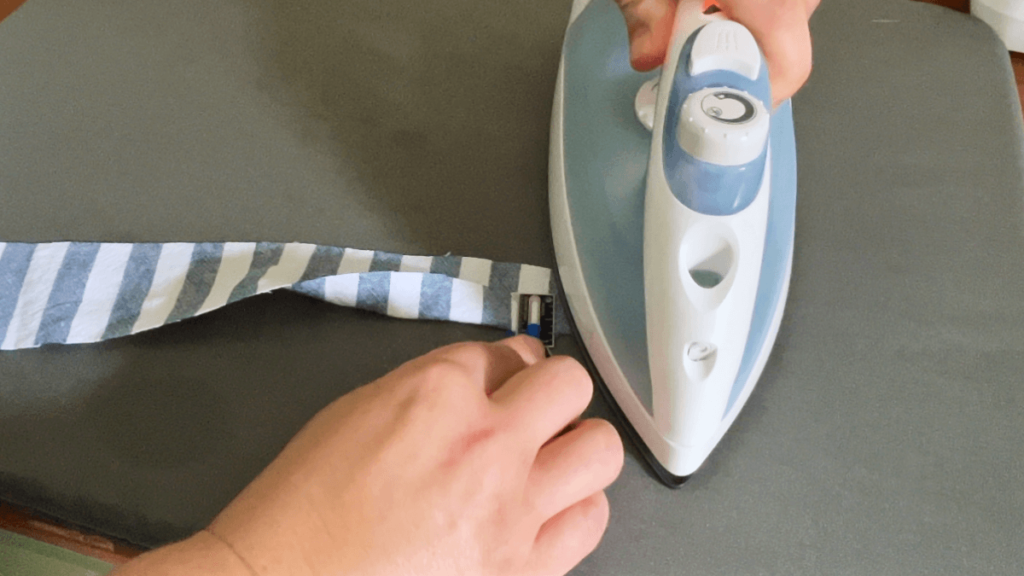
Fold the opposite long side down about 1/4 inch (don’t overlap the fabric) and press.
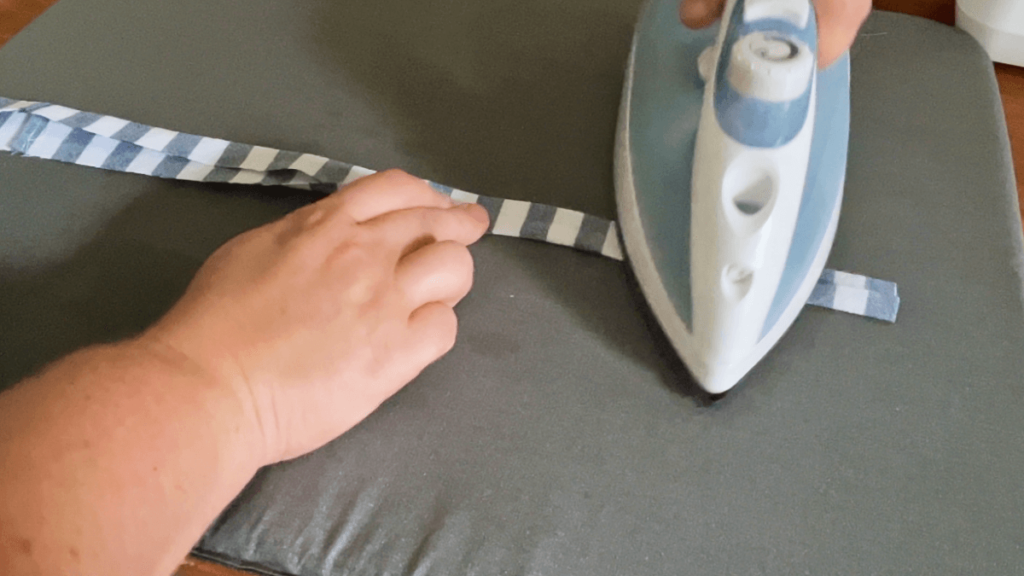
Fold the entire piece in half lengthwise and press. You can add pins if needed as well.
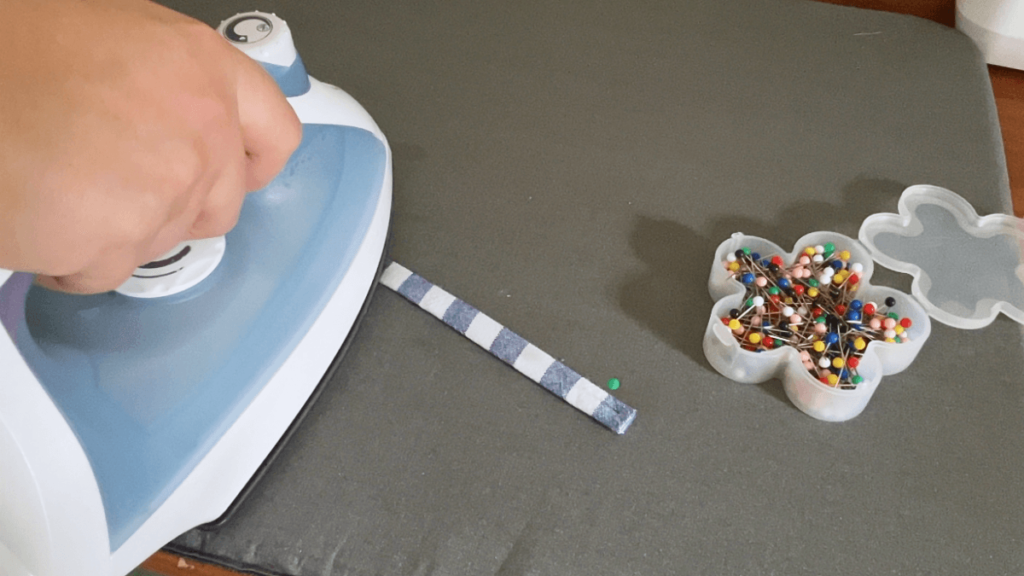
Top stitch the tie starting on the long side that has the opening. Continue to top stitch along the first short side, the other long side and lastly, the second short side. Then repeat this process for the second tie.
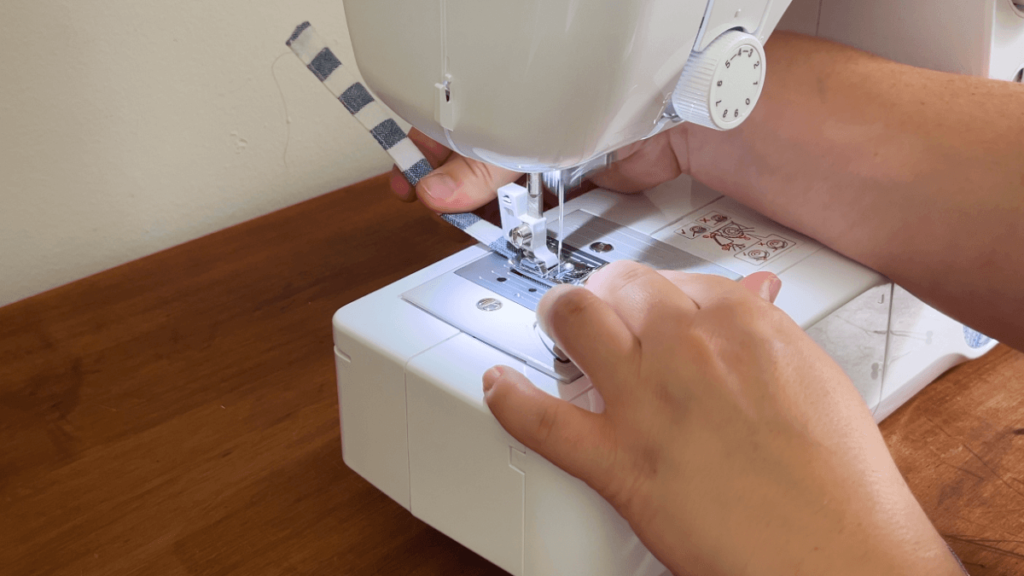
How to Assemble the Reusable DIY Bread Bag
Slide a safety pin into one of the short edges of the tie and secure it, then place the safety pin into the openings and feed it, and the tie, through the entire channel and out the other side.
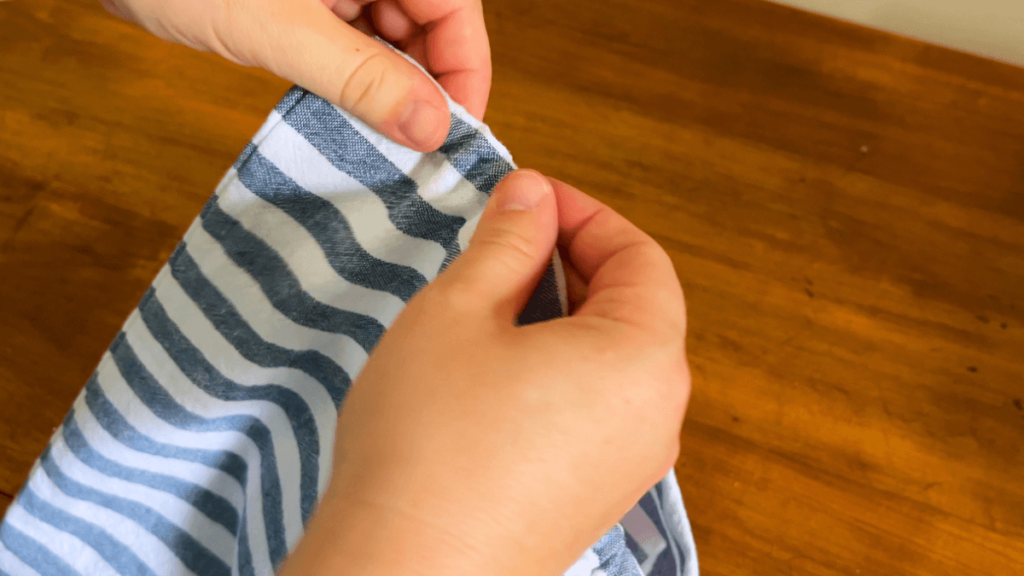
Tie a knot in the ends of each side.
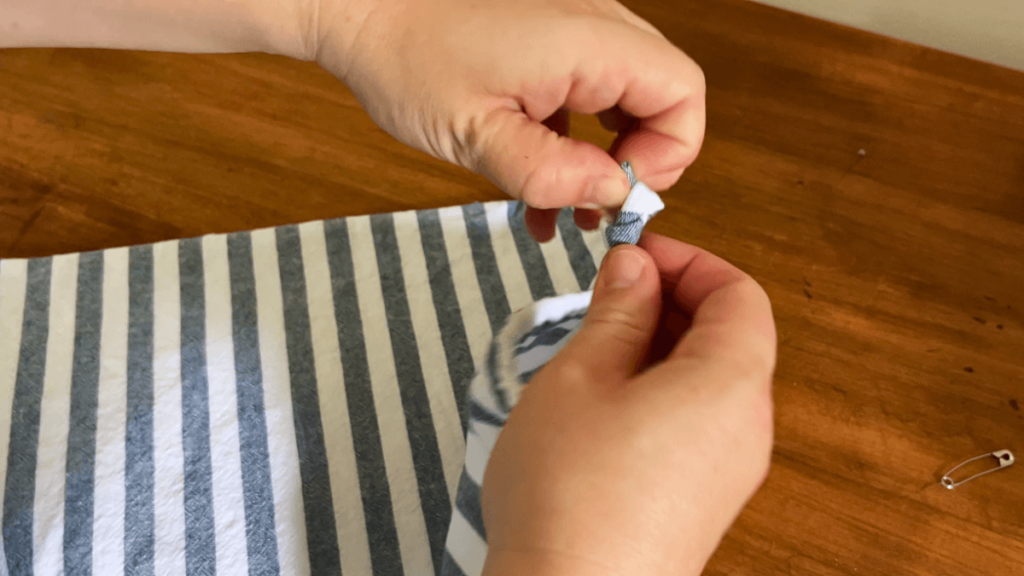
Now your bread bag is ready to use!
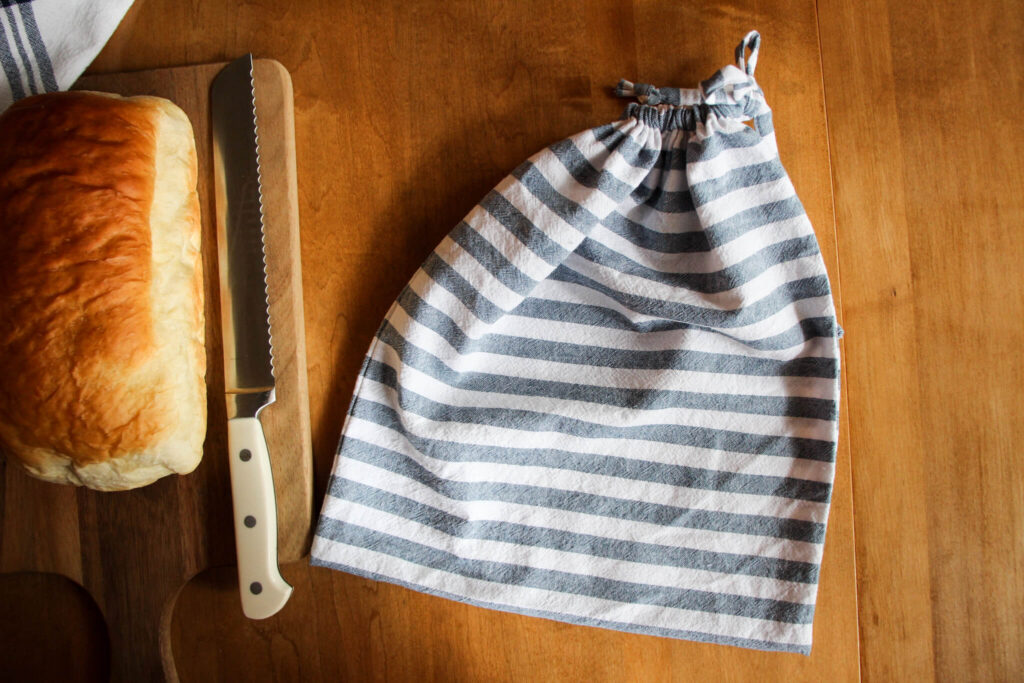
Optional Alternatives
Large Two Tie Linen Bags
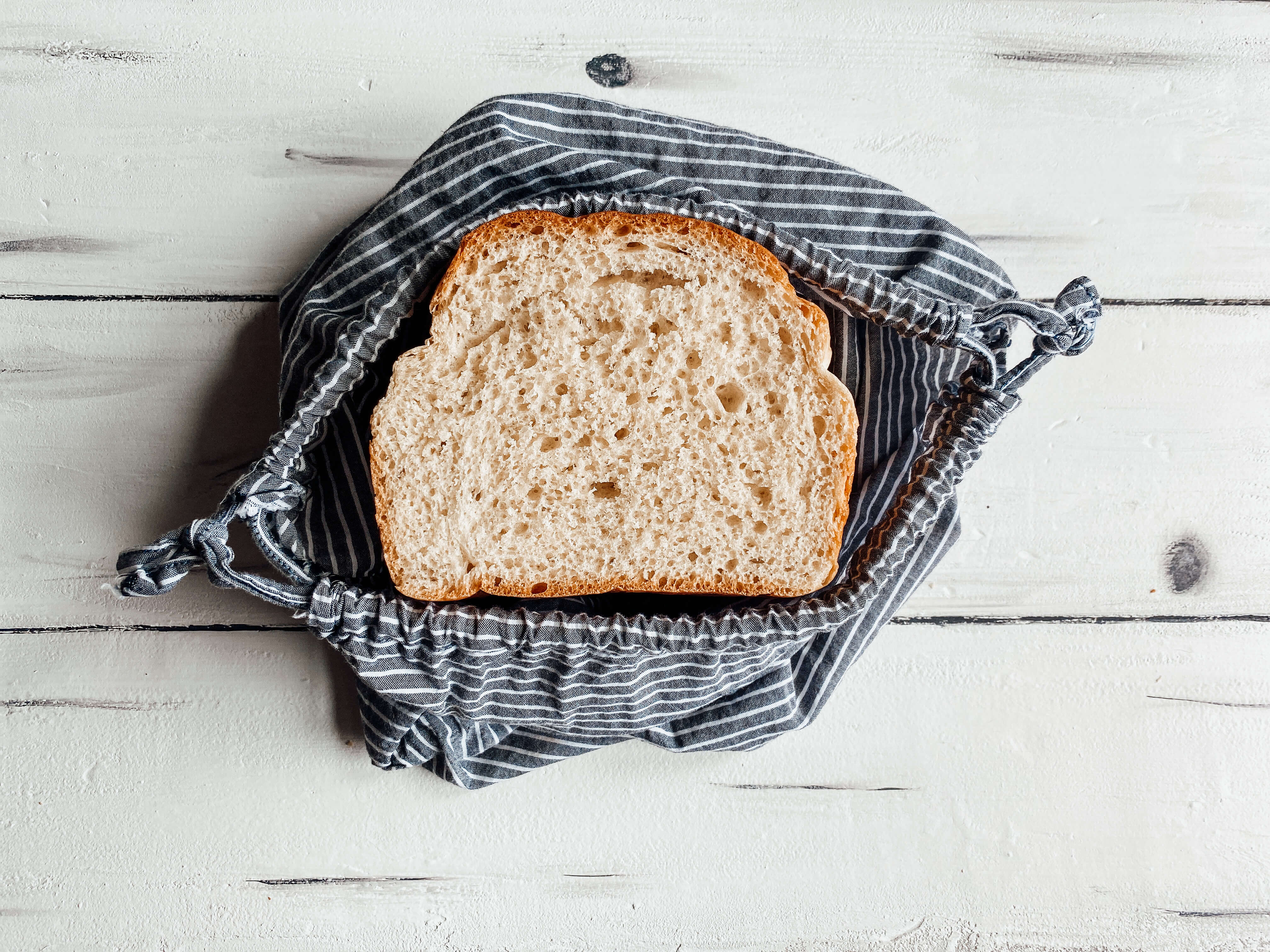
- Cut a piece of linen or 100% cotton fabric that is 30 inches long by 13 inches wide.
- Fold the cut piece of fabric in half, lining up the two short sides, with the wrong side of the fabric facing out. You should now have a piece that is 15 inches by 13 inches.
- Press the folded seam with an iron, then place a handful of pins throughout the fabric to keep the two pieces together.
- Using your fabric measuring tape, mark two inches from the top (the side that is open) and place a pin through both pieces of fabric. Repeat for the other side.
- Using a 1/2 inch seam allowance, sew along each long side, stopping at the pin. Make sure to forward and backward stitch at the top and bottom.
- For extra strength on the side seams, repeat the previous step, sewing with a 3/8″ seam allowance.
- Trim off the excess fabric on the sides you just sewed, leaving about 1/4 inch of fabric on either side. Use pinking shears if you have them to help prevent fraying.
- Flip the bag right side out and push the corners out using a blunt object like the end of scissors or a crochet hook, then press the entire bag again.
- The opening to the bag should have two separate sides. Starting on one side, fold down the top about 1/2 inch and press. Then fold it over again, lining it up with the two inch mark, and press again. Repeat for the other side.
- Turn the bag wrong sides out again, then sew the bottom of the fold (the open end) as close to the edge as you can (top stitch), making sure to forward and backward stitch at the beginning and end. This will create a channel for the tie.
How to Make the Ties for a Drawstring Closure
- Cut two strips of fabric that are 22 inches long by 2 1/2 inches wide.
- Fold each short end 1/4 inch and press.
- Fold down one long side about 3/4 inch and press. Then fold down the other long side about 1/4 inch (don’t overlap the fabric) and press.
- Fold the entire piece in half lengthwise and press.
- Top stitch starting on the long side that has the opening. Continue to top stitch along the first short side, the other long side and lastly, the second short side. Then repeat this process for the second tie.
How to Assemble the Reusable DIY Bread Bag
- Slide a safety pin into one of the short edges of the first tie and secure it.
- Place the safety pin in one of the openings and feed it, and the tie, through the entire first channel and out the other side. Then continue feeding the tie into the other channel on the opposite side. Each end of the tie should be coming out of each of the two openings.
- Repeat the process with the second tie, but feed the safety pin and tie into one of the openings opposite the ends of the other ties. It’s the opposite side you fed the first tie through.
- You should end with having two ends of one tie on the left side and two ends of the other tie on the right side. Tie a knot in both ties as close to the end as you can.
- Now your bag is finished! You should be able to pull on both sides of the ties and close the bag!
Small One Loaf Option

For the one loaf option, the process is the previous size but the dimensions are slightly different.
- Cut a piece of 100% cotton fabric that is 30 inches long by 9 inches wide.
- Fold the cut piece of fabric in half (hamburger style) with the wrong side facing out. You should now have a piece that is 15 inches by 9 inches.
- Repeat the same process above to complete the one loaf bread bag.
How to Make the Ties
- Cut two strips that are 20 inches long by 2 inches wide.
- Complete the ties following the same steps above.
- Assemble the bag the same as above.
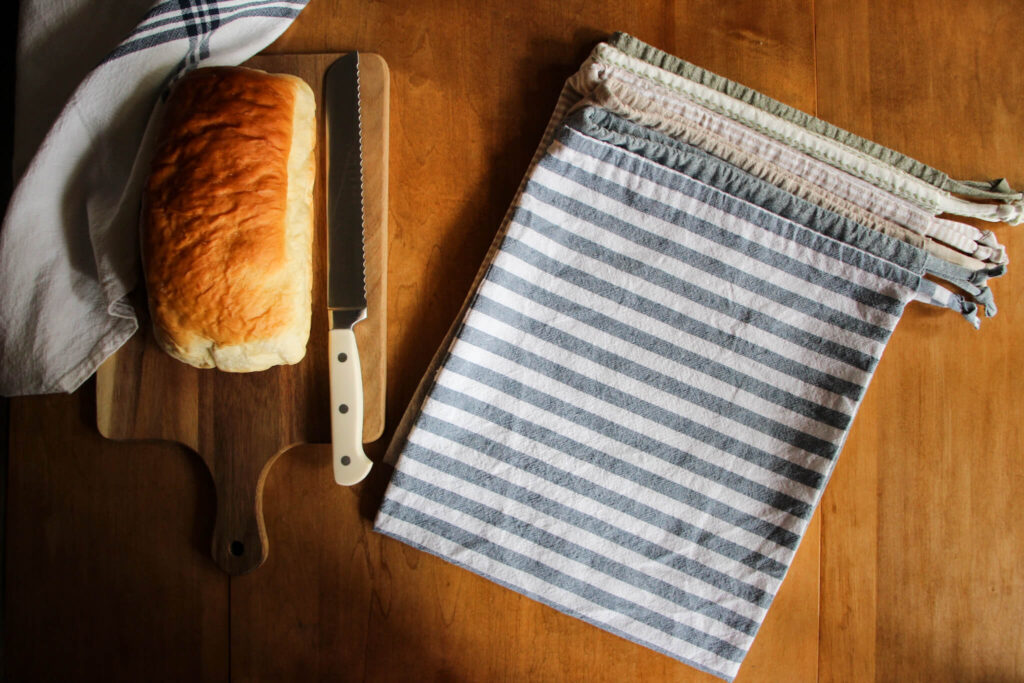
NOTES
- Try getting your fabric at a place like Joann or Michaels because they usually have sales and coupons!
- Use a fabric that is 100% cotton, linen or some other breathable material to create a nice airflow for your bread.
- Use a cotton or all purpose thread that is in a coordinating color to your fabric.
- Wash and dry your fabric prior to making your reusable bread bags. You want to pre-shrink your fabric so your bag doesn’t shrink when you wash it after it’s finished.
- Wash your dirty bread bag on cold water and dry on low heat.

How to Make a Reusable DIY Bread Bag
Reduce plastic waste and learn how to make a reusable DIY bread bag that keeps homemade bread, fresher longer and makes for a great gift for the bakers in your life!
Materials
- 1/2 yard 100% cotton or linen fabric
- 100% cotton or all purpose coordinating thread
Tools
- Sewing machine
- Iron and ironing board
- Rotary cutter and cutting pad
- Scissors
- Pinking sheers (optional)
- Fabric tape measure
- Pins
- Safety pin
Instructions
Large Size
Cut a piece of linen or 100% cotton fabric that is 30 inches long.
Fold the cut piece of fabric in half, lining up the two short sides, with the wrong side of the fabric facing out. Press the folded edge with an iron, then place a handful of pins throughout the fabric to keep the two pieces together.
Trim the selvage edge from the left side of the fabric then cut the fabric to a width of 13".
Using your fabric measuring tape, mark two inches from the top (the side that is open) and place a pin through both pieces of fabric.
Using a 1/2 inch seam allowance, sew along each long side, making sure to forward and backward stitch at the top and bottom. On the side with the pin, be sure to stop when you get to the pin.
For extra strength on the side seams, repeat the previous step, sewing with a 3/8" seam allowance.
Trim off the excess fabric on the sides you just sewed, leaving about 1/4 inch of fabric on either side. Use pinking shears if you have them to help prevent fraying.
Flip the bag right side out and push the corners out using a blunt object like the end of scissors or a crochet hook, then press the entire bag again.
At the top of the bag where the opening is, fold down the raw edges about 1/2 inch and press. Then fold it over again, lining it up with the two inch mark, and press again.
Turn the bag wrong sides out again, then sew the bottom of the fold (the open end) as close to the edge as you can (top stitch), making sure to forward and backward stitch at the beginning and end. This will create a channel for the tie.
How to Make the Ties
Cut a strip of the same fabric that is 31 inches long by 2 inches wide.
Fold the short ends 1/4 inch and press.
Then fold down one long side about 3/4 inch and press.
Fold the opposite long side down about 1/4 inch (don’t overlap the fabric) and press.
Fold the entire piece in half lengthwise and press. You can add pins if needed as well.
Top stitch the tie starting on the long side that has the opening. Continue to top stitch along the first short side, the other long side and lastly, the second short side. Then repeat this process for the second tie.
How to Assemble the Reusable DIY Bread Bag
Slide a safety pin into one of the short edges of the tie and secure it.
Place the safety pin into the openings and feed it, and the tie, through the entire channel and out the other side.
Tie a knot in the ends of each side.
Notes
- Try getting your fabric at a place like Joann or Michaels because they usually have sales and coupons!
- Use a fabric that is 100% cotton, linen or some other breathable material to create a nice airflow for your bread.
- Use a cotton or all purpose thread that is in a coordinating color to your fabric.
- Wash and dry your fabric prior to making your reusable bread bags. You want to pre-shrink your fabric so your bag doesn’t shrink when you wash it after it’s finished.
- Wash your dirty bread bag on cold water and dry on low heat.
CHECK OUT MORE SEWING PROJECTS
Looking for other easy sewing projects? Check out these:
- How to Sew Tea Towels
- How to Sew Reusable Fabric Bowl Covers
- How to Sew a Flannel Throw Blanket
- How to Sew a Basket Liner for Rectangular Basket
I hope this inspired you to create your own linen bread bag. If you enjoyed this tutorial, I’d love to see your creations!





What a great idea!
Thank you!
I love your tutorials! This sounds awesome. I’ve never even baked my own bread but now I feel like I need to so I can make this bread bag haha!
Thank you so much! And I love that haha 🙂
I love this idea!! Genius and so green! I’ve been making homemade bread throughout the pandemic, and my fam has requested we keep it up! So yummy! These bags are perfect. Not a great sewer, tho…happy for your tutorial! 😉 Thank you!
Thank you! I’ve been making bread a lot more over the last year! I hope the tutorial helps! I’m still very new to sewing, so if I can do it, I’m sure you can too!
I love this tutorial! I’ve been wanting to buy bread bags like these but I think I might try making some instead!
Thank you! Happy sewing 🙂
Well, this is just the most perfect craft. Thanks for this tutorial!
Thank you so much 🙂
This looks so good! What a great staple to have in hand!
Thank you! I’m glad it was helpful to you 🙂
Thanks for sharing! Does it help long?
I find it helps to keep the bread fresher longer, for sure!
Can you use these to freeze bread as well? I like to make a couple loaves at a time and freeze one.
That’s a great question! You definitely can use these for freezing bread, especially if it’s for a short period of time. If it’s for a long period of time, I like to use plastic gallon bags or silicone bags because I think they are better at keeping the bread from getting freezer burnt. Hope that helps!
Thanks!!!
Hi….Such a simple to follow tutorial. Do you finish off the side seams at all to prevent fraying? Thanks!
Thank you, I’m glad you thought so 🙂 I don’t finish off the side seams, but you definitely could, especially if you’re using the cotton shirting like I did in the tutorial.
What does hamburger style mean?
Here’s ab example. If you have an 8.5 x 11 piece of paper laying vertically, you would fold that piece of paper over the horizontal center, meaning you would fold the 8.5″ side over to touch the other 8.5″ side. So the paper would be wider than it is tall when it’s folded. Hot dog style would be folding the paper over the vertical line, so the 11″ side to the 11″ side. So the paper would be taller than it is wide when it’s folded. It’s hard to describe in written form, but hopefully that helps.
I need to make a few of these.
I hope you love them!
Thank you so much for this tutorial! I used it today to make 2 bread bags and they turned out beautifully.
Thank you, that’s so good to hear!
Thx so much for these instructions- starting another bag and then I’m gonna start on the dishcloth ! Love your work! And love your hamburger and hotdog instructions are genius!
Oh I’m so glad they’re helpful! Happy sewing 🙂
Can these bags be coated with bees wax before sewing?
I have not tried that yet, although I would like to soon, but I would suggest doing it after you’ve sewed the bags because you don’t want your sewing machine getting gummed up by the wax.
Hi. If I’m going to freeze the breads, can I wrap them in beeswax food wrap, then place them in the bread bag? Is there something about beeswax wrap for freezing?
You can freeze using the beeswax wraps if it’s for a short period of time, like less than a month, but it can cause them to crack and wear down. If you’re trying to freeze bread without the use of plastic, I’d recommend putting the bread in a paper bag, then in a reusable bread bag.
What fabrics are you using in your tutorial? The fabric in the Amazon link doesn’t look the same. Thank you for your help.
The fabric I use in the tutorial is linen I found at Hobby Lobby 🙂
Selvedge not salvage ☺️
Whoops, thank you!
Can you please state what size bread loaf woul fit in each size bag ? Thank you
Of course! The large size fits two standard size homemade bread loaves or one sourdough round loaf and the small bag fits one standard homemade loaf. Please let me know if you have any other questions!